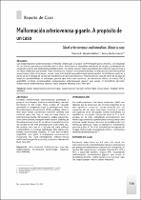| dc.contributor.author | Mendez-Mathey, Vanessa E. | |
| dc.contributor.author | Mucha-Huaroc, Kenny | |
| dc.date.accessioned | 2023-06-06T20:15:42Z | |
| dc.date.available | 2023-06-06T20:15:42Z | |
| dc.date.issued | 2019-01-24 | |
| dc.identifier.citation | Revista del Cuerpo Médico Hospital Nacional Almanzor Aguinaga Asenjo. 2018:11(2). | es_PE |
| dc.identifier.uri | https://hdl.handle.net/20.500.12959/3855 | |
| dc.description.abstract | Las malformaciones arteriovenosas cerebrales constituyen un grupo enfermedades poco comunes, y se localizan en territorios vasculares profundos del cerebro. Consisten en anomalías vasculares de origen o predisposición congénito a partir del desarrollo patológico de la red capilar que permiten conexiones directas entre las arterias y las venas cerebrales que pueden tener o no shunts o cortocircuitos arteriovenosos. Su frecuencia a diferencia de los aneurismas es diez veces menor, siendo causa principal de sangrado a nivel subaracnoideo. Su incidencia suele ser a partir de la 4º década de la vida con predominio en el sexo masculino. Presentamos el caso de varón de 63 años de edad sin comorbilidades ni patologías previas que inicia con trastorno de conciencia súbito, se realiza TAC y angioTEM cerebral encontrándose malformación arteriovenosa gigante que ocupa el hemisferio derecho; malformación arteriovenosa tipo IIIa según Spetzler- Martin y Hunt- Hess de 0. | es_PE |
| dc.description.abstract | Cerebral arteriovenous malformations constitute a
group of rare diseases, and are located in deep vascular
territories of the brain. They consist of vascular
anomalies of congenital origin or predisposition from
the pathological development of the capillary network
that allow direct connections between arteries and
cerebral veins that may or may not have shunts or
arteriovenous shunts. Its frequency, unlike aneurysms,
is ten times smaller, being the main cause of bleeding at
the subarachnoid level. Its incidence is usually from the
4th decade of life with predominance in the male sex.
We present the case of a 63-year-old male without
comorbidities or previous pathologies that starts with
sudden consciousness disorder, CT scan and cerebral
angioTEM, and giant arteriovenous malformation
occupying the right hemisphere; arteriovenous
malformation type IIIa according to Spetzler-Martin and
Hunt-Hess of 0. | es_PE |
| dc.format | application/pdf | es_PE |
| dc.language.iso | spa | es_PE |
| dc.publisher | Seguro Social de Salud (EsSalud) | es_PE |
| dc.relation.uri | http://cmhnaaa.org.pe/ojs/index.php/rcmhnaaa/article/view/75 | es_PE |
| dc.rights | info:eu-repo/semantics/openAccess | es_PE |
| dc.rights.uri | https://creativecommons.org/licenses/by-nc-sa/4.0/ | es_PE |
| dc.subject | Malformación arteriovenosa | es_PE |
| dc.subject | Hemorragia intracraneal | es_PE |
| dc.subject | Malformación vascular | es_PE |
| dc.subject | Arteriovenous malformation | es_PE |
| dc.subject | Vascular malformation | es_PE |
| dc.subject | Intracranial hemorrhage | es_PE |
| dc.title | Malformación arteriovenosa gigante. A propósito de un caso | es_PE |
| dc.title.alternative | Giant arteriovenous malformation. About a case | es_PE |
| dc.type | info:eu-repo/semantics/article | es_PE |
| dc.subject.ocde | https://purl.org/pe-repo/ocde/ford#3.02.25 | es_PE |
| dc.identifier.doi | https://doi.org/10.35434/rcmhnaaa.2018.112.75 | |






